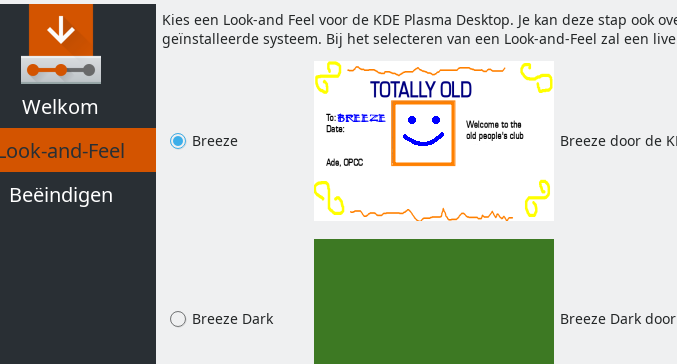Calamares and Plasma Look-and-Feel
Calamares is a Linux installer. Bluestar Linux is a Linux distribution. KDE Plasma Desktop is KDE’s flagship desktop environment. Together, these three bits of software got into a spot of trouble, but what’s more important, got out of trouble again with good communications, good bug reports and a “we can fix it” attitude.
When Calamares is run in a KDE Plasma Desktop environment, for a distro that uses KDE Plasma Desktop – and bear in mind, Calamares is a distro- and desktop-independent project, so it will just as gladly install a variant of Debian with i3 as a variant of openSUSE with GNOME as a variant of Fedora with KDE Plasma – one of the modules that the distro can use is the plasmalnf module. This configures the look-and-feel of KDE Plasma Desktop in the target system, so that after the installation is done you don’t have to set a theme again. You might think of this as one tiny part of a first-run “here’s some cool options for your desktop” tool.

The distro is expected to provide a suitable screenshot on the live ISO for use with the Look-and-Feel module; since I don’t have one, the images used here are not representative for what Breeze actually looks like.
A minor feature of the module is that it also will update the live environment – if that is KDE Plasma Desktop – to follow the selection, so on an openSUSE variant you can try out Breeze, Breeze Dark and the openSUSE theme before installation.
Anyway, Bluestar Linux uses this module, and reported that the Look-and-Feel module was not correctly writing all of the keys needed to switch themes. And, here’s the thing, they reported it. In the right place (for me), which is the issue tracker for Calamares. And they described the problem, and how to reproduce the problem, and what they expected.
Give yourself a pat on the back for writing good bug reports: it’s amazing what a difference there is between “it doesn’t work” and something that I can work with.
I experimented a bit – most of Calamares works on FreeBSD as well,
so I can check in my daily live environment, as well as in
various Linux VMs – and it turned out there is a difference between
what the lookandfeeltool writes as configuration, and what the Plasma Theme
KDE Control Module (KCM) writes. It’s not the kind of thing I would spot,
so I’m doubly glad for downstream distro’s that see things differently.
Having confirmed that there’s a difference, I took the problem to the KDE Plasma developers – this is where it is really useful to live in multiple communities at once.
The folks at Bluestar Linux had written a workaround already, and with the description of what was going on the KDE Plasma folks spent maybe an hour from start to finish (including whatever else goes on on a wednesday morning, so coffee, sending memes and debugging other stuff in the meantime) and we now have two results:
- Look-and-Feel tool has a bugfix that will land in the next release (Plasma releases are monthly, if I recall)
- Calamares has a workaround that landed in the latest release (Calamares releases are every-two-weeeks-if-I-can-swing-it)
So, as the person in the middle, I’d like to say “thanks” to downstream for reporting well and upstream for acting quickly. And then I can put on my sidestream hat and port the fix to FreeBSD’s packaging of KDE Plasma Desktop, too.